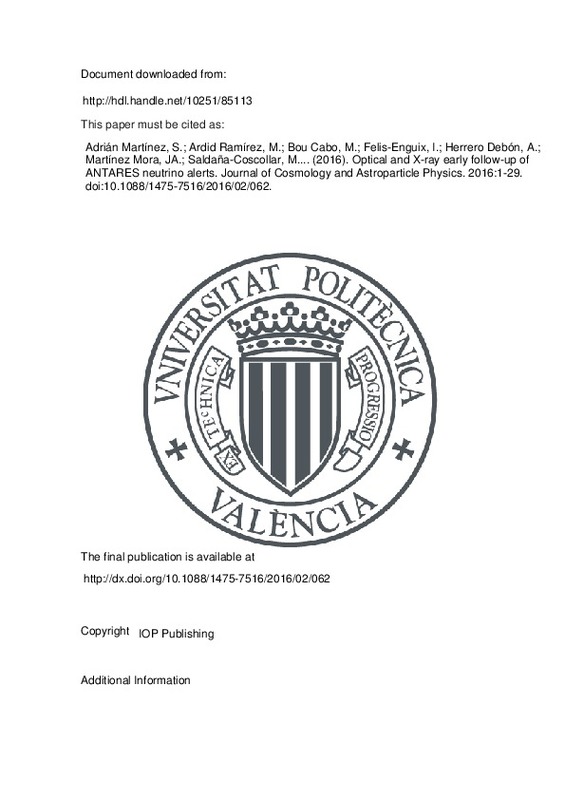|
Resumen:
|
High-energy neutrinos could be produced in the interaction of charged cosmic rays with matter or radiation surrounding astrophysical sources. Even with the recent detection of extraterrestrial high-energy neutrinos by the ...[+]
High-energy neutrinos could be produced in the interaction of charged cosmic rays with matter or radiation surrounding astrophysical sources. Even with the recent detection of extraterrestrial high-energy neutrinos by the IceCube experiment, no astrophysical neutrino source has yet been discovered. Transient sources, such as gamma-ray bursts, core-collapse supernovae, or active galactic nuclei are promising candidates. Multi-messenger programs offer a unique opportunity to detect these transient sources. By combining the information provided by the ANTARES neutrino telescope with information coming from other observa-tories, the probability of detecting a source is enhanced, allowing the possibility of identifying a neutrino progenitor from a single detected event.
A method based on optical and X-ray follow-ups of high-energy neutrino alerts has been developed within the ANTARES collaboration. This method does not require any assumptions on the relation between neutrino and photon spectra other than time-correlation. This program, denoted as TAToO, triggers a network of robotic optical telescopes (TAROT and ROTSE) and the Swift-XRT with a delay of only a few seconds after a neutrino detection, and is therefore well-suited to search for fast transient sources. To identify an optical or X-ray counterpart to a neutrino signal, the images provided by the follow-up observations are analysed with dedicated pipelines. A total of 42 alerts with optical and 7 alerts with X-ray images taken with a maximum delay of 24 hours after the neutrino trigger have been analysed. No optical or X-ray counterparts associated to the neutrino triggers have been found, and upper limits on transient source magnitudes have been derived. The probability to reject the gamma-ray burst origin hypothesis has been computed for each alert.
[-]
|
|
Agradecimientos:
|
The authors acknowledge the financial support of the funding agencies: Centre National de la Recherche Scientifique (CNRS), Commissariat a l'energie atomique et aux energies alternatives (CEA), Commission Europeenne (FEDER ...[+]
The authors acknowledge the financial support of the funding agencies: Centre National de la Recherche Scientifique (CNRS), Commissariat a l'energie atomique et aux energies alternatives (CEA), Commission Europeenne (FEDER fund and Marie Curie Program), Region Ile-de-France (DIM-ACAV), Region Alsace (contrat CPER), Region Provence-Alpes-Cote d'Azur, Departement du Var and Ville de La Seyne-sur-Mer, France; Bundesministerium fur Bildung and Forschung (BMBF), Germany; Istituto Nazionale di Fisica Nucleare (INFN), Italy; Stichting voor Fundamenteel Onderzoek der Materie (FOM), Nederlandse organisatie voor Wetenschappelijk Onderzoek (NWO), the Netherlands; Council of the President of the Russian Federation for young scientists and leading scientific schools supporting grants, Russia; National Authority for Scientific Research (ANCS), Romania; Ministerio de Ciencia e Innovacion (MICINN), Prometeo of Generalitat Valenciana and MultiDark, Spain; Agence de l'Oriental and CNRST, Morocco. We also acknowledge the technical support of Ifremer, AIM and Foselev Marine for the sea operation and the CC-IN2P3 for the computing facilities. We gratefully acknowledge financial support from the OCEVU LabEx, France. PAE andJPO acknowledge support from the U.K. Space Agency.
[-]
|







![[Cerrado]](/themes/UPV/images/candado.png)


